Turquoise Energy Report #181 - June 2023
Turquoise Energy News Report #181
Covering
June
2023 (Posted July 12th 2023)
Lawnhill BC Canada - by Craig Carmichael
[CraigXC at Post dot com]
www.TurquoiseEnergy.com
= www.ElectricCaik.com
= www.ElectricHubcap.com
Month In "Brief"
(Project Summaries etc.)
- Two Videos: Bandmill, NiMn2Ox electrode - "Premium" Peltier
Cooler
Experiments - & Better Peltier modules? - June Gardening -
Electric
Fields & Tinnitus Experiment - Magnetic Variable Torque
Converter -
Sprint "Mileage" - "Long" Highway Trip in Nissan Leaf - Moscow:
Electric River Ferries - China: World's Largest Wind Turbine
In
Passing
(Miscellaneous topics, editorial comments & opinionated rants)
- Discriminatory Laws and Policies - Scattered Thots - ESD
- Detailed
Project Reports
-
Electric
Transport - Electric Hubcap Motor Systems
[No
Reports]
Other "Green"
& Electric Equipment Projects
* Premium Peltier Cooler Experiments: Copper Cools Better! -
Better
Peltier Modules with Beryllium Oxide Ceramic?
* June Gardening
Electricity Storage:
Batteries [no report]
Electricity
Generation
* My Solar Power System: The Usual Latest Daily/Monthly
Solar Production log et cetera - Monthly/Annual Summaries,
Estimates, Notes
June in Brief
 Before dawn from my window
at
3:15 AM solar
time ("5:03 AM" PDT), July 12th
Before dawn from my window
at
3:15 AM solar
time ("5:03 AM" PDT), July 12th
(Rats - even edited, the camera didn't capture the colors of the
orange
sky and the
sea - way overexposed!)
Double digits into July -- Another very late report,
again, for
June! The excuse is it's summer and the days are 17 hours long
here
instead of December's 7 hours. The weather is conducive to getting
things done outside, and then I'm too tired to do a bunch of
editing
and proofreading to get TE News ready to post. But after planting
vegetables until almost the end of June, I am now getting other
much
needed and long delayed work done out in the yard. (Along with
still
watering & tending to the gardens and fruit trees.) And living
alone, I
do like to get out and socialize in the daytime - usually
somewhere 1/2
hour drive away; an hour round trip. That eats into many of my
work
days.
Two Videos
About the start of July I posted two videos on
TurquoiseEnergy youtube channel. The first was an update of the
handheld bandsaw mill. I made the improvements to the saw in about
2020
and it's covered in
past TE News issues, but those following only on youtube haven't
seen
it. I
took advantage of wanting to split some yellow cedar 4 by 4s into
2 by
2s. Not a big job for the mill, but something to get some footage
of it
cutting.
https://www.youtube.com/watch?v=yb7BkgBvXCs&t=915s
- Handheld
Bandsaw Mill Update #2: 2023
The second was about mixing up a batch of nickel
manganese
oxide for a positive battery electrode by dissolving the powders
in
acetone to reform into epitaxial (mixed substances) crystals,
which I
did last
winter/spring. I had wanted to test the cell before I posted it.
Now I
have a pile of footage to put together about assembling and
testing the
cell.
https://youtu.be/9WjVIBCuMFw
- Exploring Battery Making #5 -
Nickel-Manganates Positive Electrode
"Premium" Peltier Cooler Experiments - & Better Peltier
modules?
First
Heatsink
assembly: Hot, Peltier module, block
(thru cooler wall), Cold
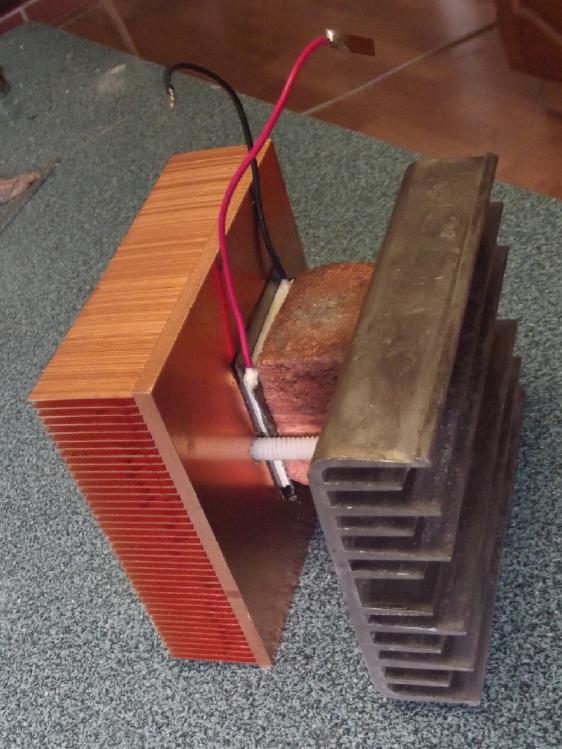 Having cast
a
copper heat transfer block, I bought a pricey copper heatsink
and ran
some tests with the same camping cooler. Then I got another copper
heatsink for the cold side too, and ran some more. Instead of
12.5°
cooling, with all copper heat transfer components it got about 16°
colder than the room. In a 20° room that makes for refrigerator
temperatures, from about 30 watts of power at 10 volts. If it's
30°
out, that still makes for 14° in the cooler instead of 17.5°.
Owing to difference of shapes and numbers of fins in the
heatsinks,
it's hard to tell exactly what features caused the improvement,
but it
was right in line with my expectations ("4° colder") for how much
better copper would be than alume.
Having cast
a
copper heat transfer block, I bought a pricey copper heatsink
and ran
some tests with the same camping cooler. Then I got another copper
heatsink for the cold side too, and ran some more. Instead of
12.5°
cooling, with all copper heat transfer components it got about 16°
colder than the room. In a 20° room that makes for refrigerator
temperatures, from about 30 watts of power at 10 volts. If it's
30°
out, that still makes for 14° in the cooler instead of 17.5°.
Owing to difference of shapes and numbers of fins in the
heatsinks,
it's hard to tell exactly what features caused the improvement,
but it
was right in line with my expectations ("4° colder") for how much
better copper would be than alume.
(I should have tried running at a higher voltage.
With the
better
components, the 'maximum cooling' voltage might have shifted up.)
"Exploded
view" of a Peltier module. Thermocouples
& conductor pads separated in different places.
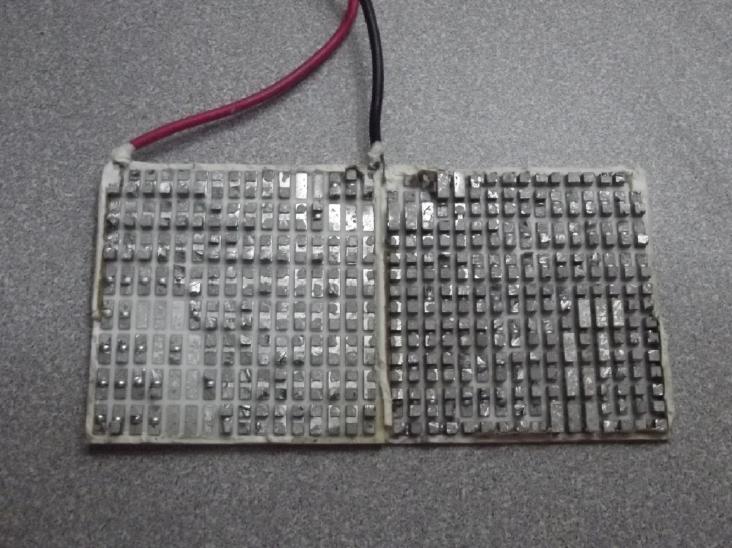 And, looking for a way
to
improve heat transfer in and out of Peltier modules themselves, I
discovered in a table that while being an electrical insulator,
beryllium oxide ceramic actually has better heat conductivity than
alume metal! It's the highest of any non-metal except diamond. A
Peltier module made with that instead of alume oxide (only 15% as
good)
would probably drop the cooler another 4° - right down to
freezing!
And, looking for a way
to
improve heat transfer in and out of Peltier modules themselves, I
discovered in a table that while being an electrical insulator,
beryllium oxide ceramic actually has better heat conductivity than
alume metal! It's the highest of any non-metal except diamond. A
Peltier module made with that instead of alume oxide (only 15% as
good)
would probably drop the cooler another 4° - right down to
freezing!
So there's a way to make a better peltier module
without
even
any breakthroughs in thermocouple technology! I was unable to
find
any made with BeO, or a reason it hasn't been done. No papers on
the
subject, nothing.
Various vacuum tubes and solid state power devices do
use
BeO ceramic. Has no one considered it?
June Gardening
Spring food gardening continued to be my main
preoccupation in
June. I continued the spring plantings I had started in April and
continued through May,
and finally had the main garden fully planted by June 26th and
considered it "done". The main work was ground preparation - and
then
keeping all the things I had planted watered, daily. I was
handicapped
and slowed by the "tennis elbow" I acquired in mid May. It took
me some days to realize it was more than just tired muscles (which
I
also had), and
in that time I probably made it worse. It was still causing pain
into
July.
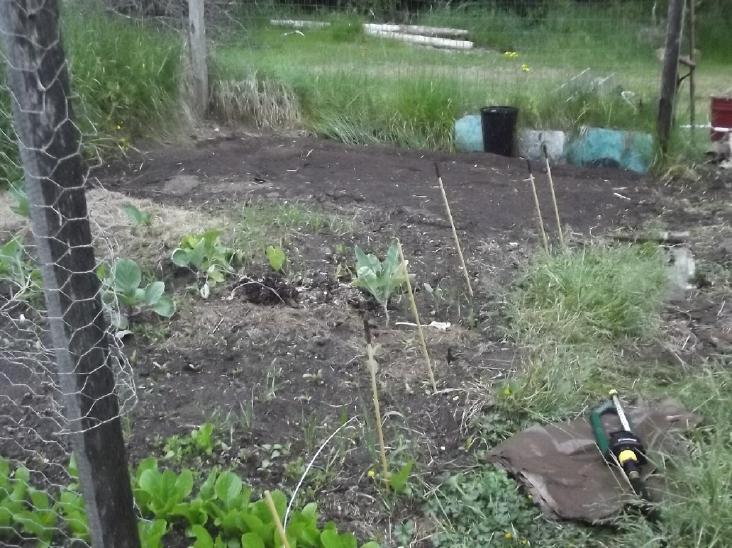 The last corner of the main
garden, cleared
& planted at last!
The last corner of the main
garden, cleared
& planted at last!
(Grass at foreground is on the center path through the garden.
Maybe
I'll till it out next year?)
(Should get that plastic melting oven done and make more slabs
to
finish lining the edges of the garden to keep grass from
growing in... or, now that I can deal with grass more easily
with the
rototiller + claw/rake + dirt sieve, maybe just finish lining
that one
side?)
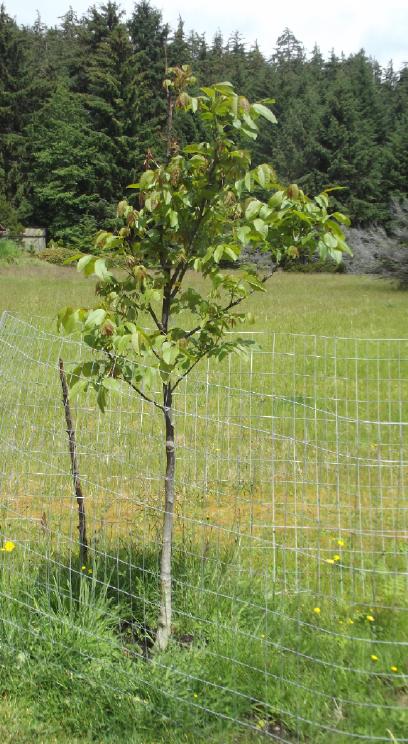
"Carpathian" variety English Walnut is growing well.
(Lots of water, check for bugs!)
 The
rototiller
I
got
last
fall,
along with "the claw" (four long, hard
tines rake), a shovel and the dirt siever, made it possible to
turn the ground in the gardens from tall grass with an
"impenetrable"
thatch of
roots into plantable soil with most of the grass and weed roots
removed. I had been wanting to do this for a few years but
breaking
through the roots with a shovel and a bad back was just too hard.
The
rototiller
I
got
last
fall,
along with "the claw" (four long, hard
tines rake), a shovel and the dirt siever, made it possible to
turn the ground in the gardens from tall grass with an
"impenetrable"
thatch of
roots into plantable soil with most of the grass and weed roots
removed. I had been wanting to do this for a few years but
breaking
through the roots with a shovel and a bad back was just too hard.
Here the northwest corner has had the tall grass
dealt
with and I can garden! I planted the beaked hazelnut by the fence,
but
mostly just filled it with potatos.
(I
went a long way to filling in a large 'pit' with all the buckets
of
grass,
weeds and roots. I suppose it will sink down a lot again as it
rots.
But for now I can finally mow around that big flowering current
with the lawn tractor.)
Electric Fields & Tinnitus Experiment
On various occasions in my life I have searched for
auditory irritants that would explain my tinnitus. Could there be
something plugged into an outlet, or wired into the house, perhaps
ultrasonic, that could explain the ringing in my ears?
Recently, corroborative stories from others clued me
in:
they explained my own one time in about 1990 when this plague
mysteriously left me just for a few days. In that, I was mostly
away
from electricity entirely for a couple of weeks, in an older
camping
trailer
with alume skin, diagonally across a big field from any power. The
high
voltage lines ended at the far corner of that farm.
So!, the audio irritant isn't anything plugged into
the
wall, it's the 60 Hz AC electromagnetic field itself, flowing
through
long wires everywhere, all around! I have become sure that
'forever'
ringing tinnitus is essentially caused by electric power
line fields - the chief and virtually inescapable culprit among
other
contributing factors such
as hearing loss. They're virtually impossible to escape from. All
the
roads
we travel have power lines running along them, and every building
is
wired and electrified. But which is the biggest culprit, the high
voltage out on the poles, or the 120/240 volts right in the house?
The
three phase high voltage was closer to my house in Victoria, but
my
bedroom there had only a few wires - a light and a couple of
plugs. My
bedroom here is lavishly
wired, with plugs on every wall, wires running under the floor to
the
garage, well pump controls and workshop, electric baseboard heat
(with
the
thermostat on another wall, so wired across), lights in the room
and
closet ceilings, and who knows what else in the attic above. And
my
tinnitus is much worse here than it was in Victoria. 'Unbearable'
or
'piercing' are fair descriptions. But I also note that when
driving in
an electric car, my tinnitus seems to get worse. In the converted
Mazda
RX7, my first EV, I thought it might be the power electronics in
the
car. But that's behind the metal hood and firewall. Now I'm pretty
sure
it's because one is always driving right underneath high voltage
power
lines - right over most every street, road and highway. The car is
metal, but the windows provide plenty of entry space. In a
petroleum
powered car, the noise level is sufficient that the 'extra'
tinnitus
goes unnoticed, and perhaps the extra after stopping is
subconsciously
attributed to the car noise.
Experiment: I got the idea one day to turn off the whole
power
to the house for the night. It's June. Perfect, I wouldn't need
heat.
In my long, sprawling house, my bed at the far end of the dwelling
space is about 45 feet from where the aerial wires enter the
house,
where they are in a pipe and so shielded to the breaker panel.
Procedure: I turned my computers off and at bedtime flipped
off
the main breaker. It feels really weird doing that. Barring
trouble,
the
house is never without power! Fridge and freezer would be off
along
with the well pump... water heater... and what else? Well, they
wouldn't thaw in 8 hours and I had already had a bath. 2 clocks to
reset. I had a 3 watt LED light in the livingroom running on the
36V DC
system (which surely can't make a 60Hz electromagnetic field)
which I
left on for a night light.
Observations: I knew 8 hours wouldn't eliminate my tinnitus
or
even come close. The one time in my adult life I was away from
electricity (and free from tinnitus) it took days to fade. But
might it
be long enough to sense something? Anything? It's tricky because
there's no way to measure dB's occurring only inside your head.
However, I was pretty
sure by morning that the intensity had faded substantially. It
felt at
least somewhat more peaceful. And within about 20 minutes of
turning
the power back on, it was bothering me more again. (In an hour,
sitting
here writing this, it is definitely louder.)
The next night I did it again. This time I didn't
notice
the ringing fading much, if any, by morning, but as the day went
on I
did notice it seeming to get worse and worse. Then I drove into
town,
1/2 hour each way, and again in the car it loudly clamored for my
attention.
By bedtime I was tempted to turn the power off again.
I
didn't.
Conclusions: It's hard to draw firm conclusions owing to it
apparently taking days for the ringing in the ears to subside
entirely
once the source of irritation is removed (at least in my case).
The
120/240V AC power inside the house seems to be
a significant contributor to my tinnitus. Turning it off for 8
hours
seemed to be noticeably helping. The 14,400V AC power line on
the power poles is farther away at its closest point, but it runs
along
the property from one end to the other and beyond. How much it
contributes could not be determined with this
experiment since I can't turn it off. If the power poles are a
lesser
effect
than the power in the bedroom, it's surely only because they are
farther away. (~95 feet - unfortunate that the house was built so
close
to the road when the property is 800 feet deep.)
I'm sure it would be folly to turn off the power
every
night with food in freezer/fridge and the potential of losing
water
pressure. Changing the extensive house wiring would be totally
impractical. So my
biggest conclusion is that I want to get on with and finish that
cabin,
shielded by aluminum clad walls and metal roof, and try further
experiments then. I can move my bedroom out
there, and also use it for any other activities that will work out
there
instead of being in the house. I'm now pretty sure the idea I
already
had to
absolutely minimize 120V line voltage wiring and to use only "BX"
shielded AC wires is the best, instead of just guessing it would
help.
(One could wrap alume tape around appliance cords, too, with a
piece
of copper wire enclosed in the wrap to ground it?) I'll wire
the cabin mostly with 36V DC for LED lights and lower power plugs.
The
four solar
panels on the roof can be employed with, um, what batteries? (Aha!
The
one from the e-bike is 36V!)
Still experimenting.
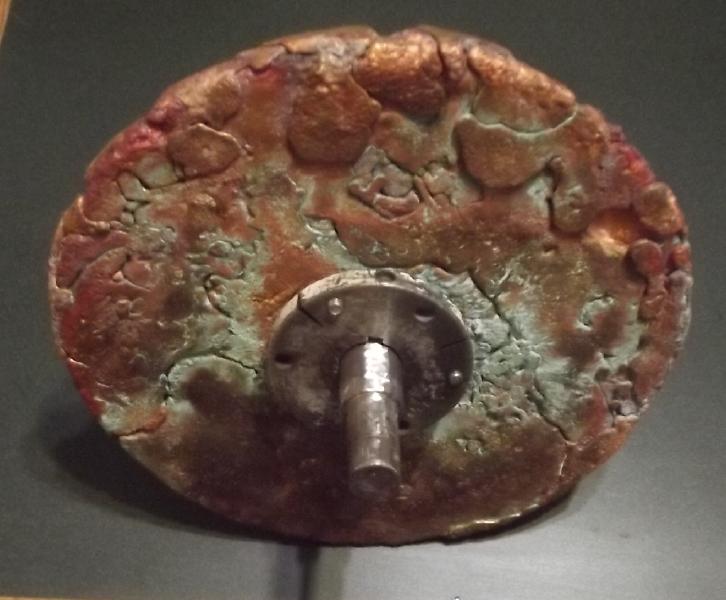 Magnetic Variable Torque Converter I
finished
filing out
the center hole in the rather dubious poured copper disk, and
attached
it to the shaft. That's as far as
I got. (Months are going by! Yikes!)
Magnetic Variable Torque Converter I
finished
filing out
the center hole in the rather dubious poured copper disk, and
attached
it to the shaft. That's as far as
I got. (Months are going by! Yikes!)
Sprint "Mileage"
On June 4th I drove the Sprint around a bit in the
yard,
hauling some heavy pails of fertilizers to the potato garden and
back.
At the end of the day, the DC solar meter said "22" had been used.
2 to
3 for the usual daily wastage... Huh? just 20 WH
for the car? That didn't make sense. But I had never tried to
measure
it before. How far had I
driven it? -- Oops, the units are x10 watt-hours, so 200 WH, not
20.
Before dark I went out again and got figures.
According to
the car's meters I drove 1.1Km (back and forth to the far end 4
times)
and
used 7 amp-hours. (There were no fractions, so that means
somewhere
between 6 and 8 depending on round-off. We'll just go with 7.) 36V
* 7
AH = 252 watt-hours, or 252/1.1 = 229 WH/Km. That's mostly at
under 20
Km/H but on rough ground (seemed quite fast!) with a lot of back
and
forth, starting and stopping, so probably considerably more than
it
would use on the street.
The next day (June 5th) it seemed from the solar DC
charging (340 WH) that the car had used around 290 WH/Km. That is
at
least in the ballpark, but quite high.
But also noted: afterward my DIY forward-reverse
switch
made from copper water pipes, taking the full amps of the motor,
was
boiling hot with a hiss if I touched a wet finger to most of the
contacts. Electric heat, the biggest user of energy! - how much of
the
total is that taking up? Maybe I should bypass it and try the test
again? (I'll have to push the car to go backward again? Ug!) Still
I
want to build that ultra-efficient unipolar "Electric Hubcap"
axial
flux BLDC motor! Will I ever get to it?
[June 12th] I backed out of the garage and then un-wired the
forward-reverse switch. Start readings: 119AH, 3.3Km. I managed to
get
the car stuck in the rough and used surely a couple of amp-hours
spinning the wheel trying
to get it out. (Having no reverse provides extra challenges.) Then
I
thought to tow it
out with the Leaf -- It pulled up the rough slope easily.
Undaunted, I tried
again from 111AH, 4.5Km. This time I drove 1.0Km using 5AH. At 36
volts: 180 watt-hours. That still seems a little high, but better
than
last
time. Of course it was still bumpy, hilly lawn with as much
maneuvering
and
turning as straight driving. And of course, an ultra-efficient
drive
train is only partial compensation for a lower efficiency motor
(series wound brushed DC). (The Sprint hit 21.8 KmPH at one point,
but in both cars 15-17 seemed pretty fast on this terrain. Later I
drove on somebody's long road into his place that made my bumpy
grass
lane seem like a
highway!)
"Long" Highway Trip in Nissan Leaf
On the 9th I Drove to Masset (170Km round trip) in the electric
Nissan
Leaf that doesn't go 170Km, and charged at the new 'ChargePoint'
charging station.
The distance to Masset (as it happens) is exactly
twice
that of my usual longest drive to Port Clements, which is en
route:
42.5Km and 85Km. So driving just one way to Masset is as far as I
usually ever drive on a charge. And I knew that the less energy I
used
on the way up, the shorter the charging would be to get back to
"enough" to get home - aiming for over 90%.
I filled the tires to the maximum 44 PSI and drove
the
whole trip at around 65 KmPH instead of my usual 75-85. I must
have
pulled over and let traffic
by about a dozen times. I wouldn't have dared make the trip at all
except on such un-busy highways. But if I remember right somehow
it had
40% remaining when I reached Masset (after lunch and a 2-3% 120V
charge
at the cafe midway), and 35% when I got home. The slow speed and
warm
weather made the
difference. I was getting between 1.4 and 1.5 Km for each percent
of
battery drop instead of maybe 1.2. (In cold weather it can be down
to
1.0 - even worse in snow.) The meter figure said 8.2 WH/Km and
even 8.4
at one point, instead of mid to lower end of 7.x.
I had a hard time at the 'ChargePoint' charger - the
'FLO'
card I had got and thought I had opened an account on said
"unrecognized card". I had to find the charger ID number and
(after
considerable back and forth) get a guy at Chargepoint on the phone
to
unlock the unit
remotely. I'd have had to charge at least 6 hours at a regular
plug-in
to get home. Anyway this was a 5.8KW charger and it was fully
charged
("98%") in a little over two hours. I would have loved to have
tried
all this out at a charging station closer to home where it wasn't
vital
that it work, but that's the only one on the island so far. I
think
I'll suggest the
municipality get a Chargepoint card so they can help the next
ignorant
visitor - it's
right outside their office, and it was their phone I was using. Or
am I
the only one?
(Apparently with a cellphone I could have downloaded an app, got a
'ChargePoint' account, and done it all myself.)
Later I went to the computer and put the minimum 10$
on my
FLO card account. I suspect that even tho the card and the charger
were
both supposedly "free", that it didn't acknowledge my account
because
there was no money in it. I'll try again and hope I don't have to
call
for support again. (It also makes me a bit nervous that just
possibly
someone else might be using the charger, and there's only one!)
I was talking with Tom, and he didn't think FLO cards
worked at all on Chargepoint chargers. He said he would mail me a
Chargepoint card he had no more use for, and since thecharger is
free
it didn't need money on its account.
Let's see... 2+ hours charging, and I spent almost
350$ in
all the main stores in Masset. It would have been cheaper to buy
gas
and blow town
quickly! (but I got some good stuff, most of which I had already
wanted.)
I didn't know these chargers were 5.8KW. So... they
call a
3.8KW charger "3KW", but a 5.8KW charger "6KW". Hmpf! It sounds
like
double, but it's only 1.5 times more.
More new EV chargers have gone in: a Tesla one
[J1772] at
the Skidegate Band office that needs no card, which I tried out
for a
minute just to see it work, and one I haven't seen yet at Sandspit
airport. That one I might use as a Sandspit round trip is near the
limit of the Leaf's range.
New Electric River Ferries
These "bus like" vessels are for traveling along and
crossing the Moscow river. Apparently there are places when travel
time
can be cut by taking a ferry instead of roads & bridges, and a
ferry service cut 30 years ago has been reinstated in electric
form.
And you get a great view! From the article it sounded like this
was an
initiative of the mayor of Moscow, Sergei Sobyanin.
President Vladimir Putin (of course) took part in the
opening ceremony and rode on one. He praised the work, "Everything
is
simple, constructive, nicely done", and thought there should be
more
like them, on routes between cities as well.
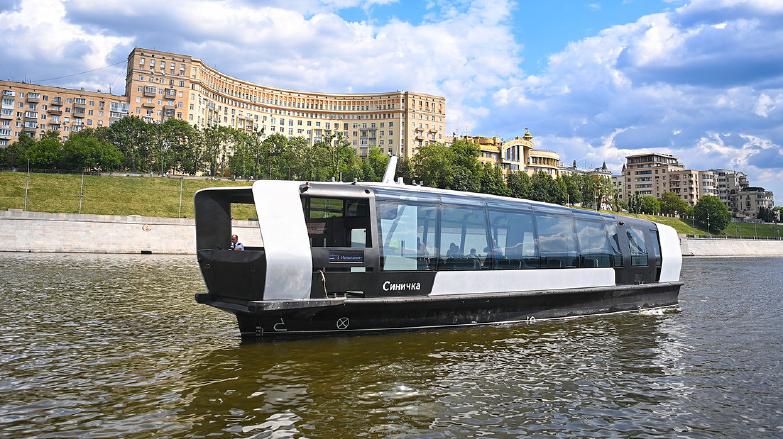
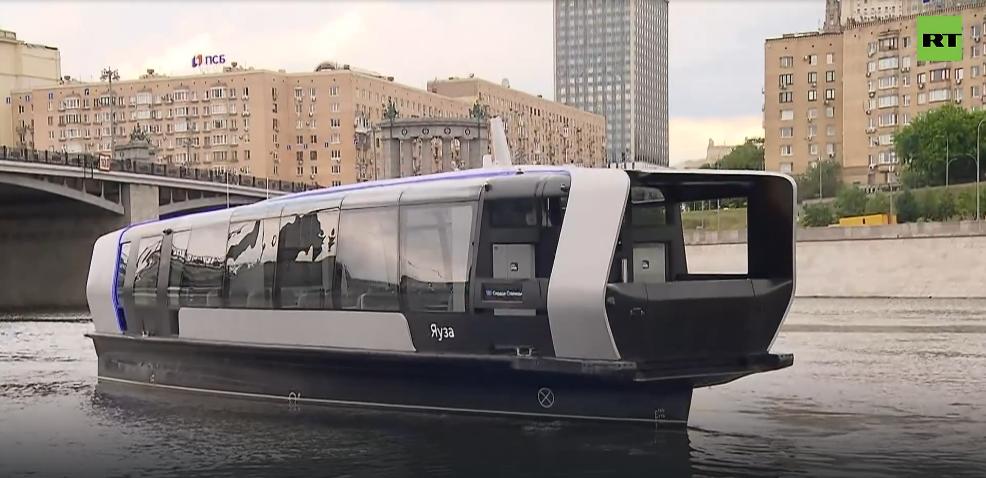 Two of the Eight new
E-Ferries,
"Sinichkha" and
"Yaooza"
Two of the Eight new
E-Ferries,
"Sinichkha" and
"Yaooza"
(Yowza?!? What kind of a name is that?)
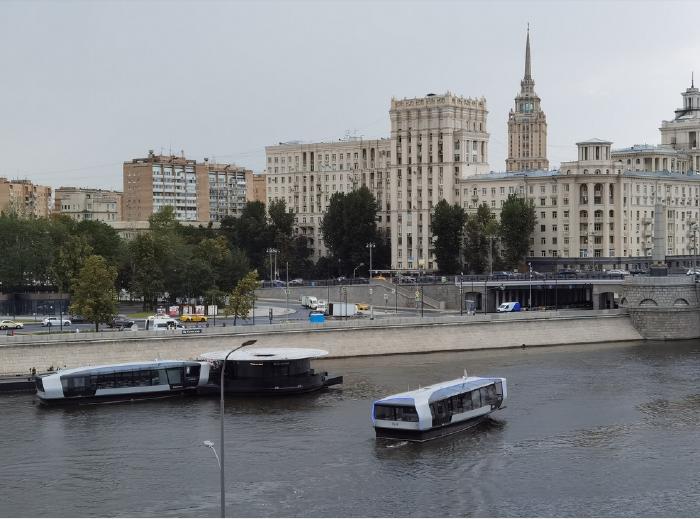
From the article:
The first route has a length
of more than 6.5 km and connects Kiev railway station with a
pier on
Shelepikhinskaya embankment. According to experts, its carrying
capacity will be 15-16 thousand passengers per day.
It is noted that eight electric vessels with a capacity of up to
50
people, named after the capital's rivers, will run along the
route:
Sinichka, Setun, Presnya, Filka, Skhodnya, Ramenka, Yauza and
Neglinka
".
The President boarded the Skhodnya and got acquainted with the
equipment of the passenger cabin of the ship.
During the President's visit, Moscow Mayor Sergei Sobyanin
explained
that the ship's dock at each berthing station also performs a
charging
function.
The mayor also announced on his Telegram channel that the main
elements
of the electric ships were produced in Russia, including all the
software. Sobyanin noted that USB chargers are installed in the
cabin
of the ships, free Wi-Fi is available, and platforms for
transporting
scooters and bicycles are provided. According to him, until June
23
inclusive, travel on the new mode of transport will be free.
According to the data provided by the mayor, passengers will be
able to
get from the Kievsky railway station to the Moscow City business
center
in about 20 minutes. Another regular route, Avtozavodsky Bridge
-
Pechatniki, 13 km long, is planned to be launched before the end
of the
year.
Hey, Vancouver -- Burrard Inlet, Fraser Delta!?!
BC -- Small Gulf Islands Electric Ferries?
World's Largest Wind Turbine
China is installing (has installed?) the world's biggest wind
turbine,
offshore,
diameter 160 meters. Each rotation of the blade generates more
electricity than my solar system makes on a whole summer day.
(hmm,
what
is the RPM - or RPDay?)
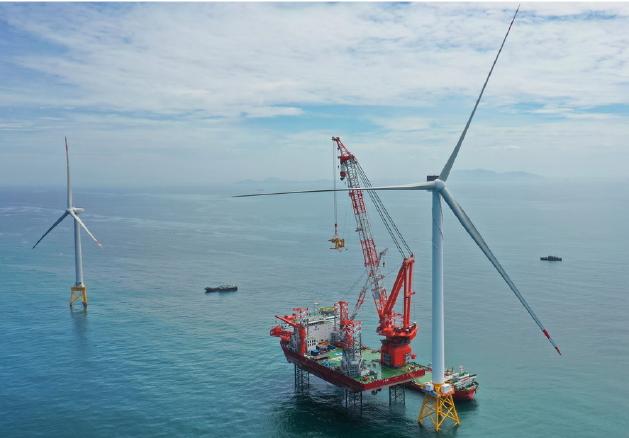 From the
article:
From the
article:
According to the China Media Group company,
the
turbine has a capacity of 16 megawatts (MW), which will allow it
to
generate 34 kilowatt hours (kWh) of electricity each time it
completes
a turn.
https://actualidad.rt.com/actualidad/471708-instalan-china-primera-turbina-eolica-grande-mundo
It is estimated that the annual electricity production is 66
million
kWh, allowing to satisfy the normal electricity consumption of
36,000
families of three members. This power generation capacity
represents a
saving of 22,000 tons of standard coal, as well as a reduction
of
54,000 tons of carbon dioxide.
Personally, having tried
running a cheap windplant over my roof, I found both the bearings
that
aim it and the actual propeller blade bearings were going bad
quickly
in the salty sea air of a good easterly wind at my house. I thus
question how long a windplant on the ocean lasts, and how much
maintenance it requires. (I suppose bearings for such huge
machines are
made replaceable, and the housing is a long way above the water.)
And
for all the reputation of Haida Gwaii as a windy place and at the
best
point on my roof, most of the month it just sat without turning.
When
wind did blow, it might produce 50 or 200 watts for a few hours.
Outperforming the solar panels was a rare event. Perhaps wind is
economic at huge scales in especially windy locations, and perhaps
if I
had put up a really tall tower (above the trees) it would have
fared
better, but for home
use solar PV with no moving parts to wear out seems more
practical, and
someone else I talked with recently was saying the same thing.
Even in
the winter when there's little sun in the clouds this far north,
the
windplant didn't seem to add much.
In
Passing
(Miscellaneous topics, editorial comments & opinionated rants)
Discriminatory
Laws
and
Policies
Discrimination has been enshrined in a new New
Zealand
Law: Surgeons now must
weigh in Race/Ethnicity in their calculations of priorities, where
someone of Maori and Pasifica extraction will get treatment ahead
of
someone of another race in a condition of similar seriousness.
Surgeons
aren't happy with being told not to use their best judgment as to
patient priorities. This is of course only one example of
many
prejudiced laws, statutes or policies in force or being enacted in
many
lands.
How can one solve past or even present
discriminations by making laws that create new
discriminations now and into the future? Racial discrimination
enshrined
in present laws or policies should be identified and eliminated,
whether it favors or disfavors blacks, Latinos,
whites, indigenouses, Chinese, Jews, Christians, men, women
or any
other grouping. Any
individual wronged by discriminatory laws or practices should be
compensated as far as is possible and
reasonable, on an individual basis. Beyond that, the past is
history.
It can't be undone, and long past events can't be fairly judged by
today's social conditions and moral standards. If we were to judge
most
of our
ancestors by today's standards, we would
condemn most all them for being cruel
barbarians, and then we would have no ancestors.
The present is the only time when choices can be
made. We
cannot now decide to change the past. It has already happened.
most of
it long before our time.
In the
darkest hours of World War Two many in
the UK parliament wanted Inquiries set up to assess blame for who
was
responsible for Britain being so unprepared for war in such
dangerous times. The new prime
minister Winston Churchill had been out of office for a decade.
Yet he
had
been clearly and repeatedly and with increasing urgency warning in
parliament for at least six years (backed by facts and
figures from inside sources) that the government needed to
prepare, and
so he had at least as much right to cast blame and render
judgments as
anyone. Instead he said: "If the present
seeks to sit in judgment on the past, it will lose the future."
Everyone stopped looking backward with resentment and righteous
indignation. They forgave and forgot. Instead of getting trapped
in
rehashing the past, they all united and focused their
energies on the
present effort to save the future.
Is this not the way forward at most any time?
In spirit, all normal minded people are equal. We are
each
indwelt by the Spirit of the Universal Father, the first source
and
center of all infinity, and are entitled to equality
of treatment. That does not of course mean we all have like
talents,
like desires and like preferences in all things, nor equal
and
like
life
experience, temperament or outlook, nor that five year olds are
the
same as
adults nor women the same as men. We are each unique. But we are
ALL
human beings. EQUALITY is
the start of the seven core values of being human, and laws and
actions
giving any
group preferential treatment or perpetuating discrimination or
inequality in any form
will set group against group, creating divisive feelings -
prejudice
and potential
strife - instead of uniting us.
Even the limited use of racial classifications
divided the
US Supreme Court for decades. In 2017, Chief Justice John Roberts
declared:
"The way to stop
discrimination on the basis of race is to stop discriminating on
the
basis of race."
How simple is that?
Scattered
Thots
* Running loud power tools without hearing protection is a deaf
defying
act.
* When someone expresses the thought that being invaded by a
foreign power might be an improvement, you know he
doesn't think much of the present government.
* A line appearing on Fox News, "Wannabe Dictator Speaks at the
White
House after Having His Political Rival Arrested", won its writer
immediate unemployment. In truth it's the entire unelected,
oligarchic,
dictatorial Washington
establishment that fears and hates with an intense passion anyone
who
tries to interfere with their hegemony. They despised Trump from
that
moment in 2015 when he pointed out that they knew and had lied
about
"weapons of mass
destruction" to "justify" invading Iraq, and said he would get
America
out of foreign wars and entanglements to focus on "Making America
Great
Again".
He was hampered and blocked at every turn. Now he has repeatedly
said
that if elected president again he would end the
Ukraine conflict in 24 hours. No wonder they hate him! Why, the
whole
US war and arms manufacturing machine would grind to a halt
without any
wars! The US establishment would be adrift and aimless, without
purpose! ...also deprived of its greatest "windfall" source of
ill-gotten wealth.
NO MORE
WARS?!?
NO MORE WARS!
NO MORE WARS!
NO MORE WARS!
(Wouldn't something more like my idea in March [TE News #178, in
"scattered thoughts"]
to allow the residents of each oblast (province/state) of
Ukraine to
vote, by choice ranking,
for any one of several options for their own future national
affiliation, make more sense than this war?)
But then, Trump has said that if re-elected he would
dismantle the entire unelected "deep
state". Wouldn't that be too good to be true? The battle lines are
drawn. They will pull anything and everything to prevent him from
running for
president again, or failing that, rig the election regardless of
how
blatantly. Their survival as unelected oligarchs and democracy
have
become completely incompatible. If the CIA, NSA, DHS... ... ...
and the
utterly corrupted FBI, DOJ... ... ... and various feral major
corporations will (as seems inevitable) not go peacefully into the
night, I suspect there will be much bloodshed and maybe a complete
breakdown of the US federal government.
* Will society break down? Trust keeps it together. If not trust
in
rule of law and democratic fairness, at least trust that basic
order
will be
maintained. Trust that there will be grocery stores with food.
Trust
that traffic will flow freely and supplies will reach
those stores without being hijacked or diverted by force. It is
said
that we are always just a few meals away from anarchy.
In recent
years, bit by bit, event by event, trend by trend, that trust is
being
eroded. Food shortages and empty grocery shelves are increasing.
In at
least USA the supply
chains are breaking down and stores are closing owing to
widespread
theft and
violence. (For example, in Chicago four of eight Wallmarts
recently
shut down, leaving "food desert" neighborhoods where there are no
grocery stores.) I'm not sure things are so much better in big
Canadian
cities.
When trust is lost, there will inevitably be mass
panic in
the
cities, and people all over will try to get what they need for
themselves and their families NOW. Everything gets looted.
Society's
future is cast adrift. Planning for next week, next year becomes
impossible when whatever one produces or has is likely to be
stolen by
desperate
people. In the typical pattern of famine, farmers stop farming
because
their produce is confiscated by the government or stolen. Not only
their work, but the resources they need to continue, such as seeds
for
next planting season, have been taken from them.
In most Western nations, those in positions of
authority
aren't even trying to fix anything. They've assumed things will
always
carry on regardless of their actions, or have given up. Either way
they
have abdicated the responsibilities of their offices even before
being
elected to them. Their interest is in getting "rich", and the
promises
they keep are to their donors, not to the electorate. I don't know
when
the day of loss of trust and mass
panic will happen. It could be a month or a year or five years
off. I
don't know if it will start community by
community, state by state, nation by nation, the whole West, or
entirely worldwide nearly all at once, but today's news is ever
worse
than last year's and walking city streets ever less safe. It will
probably be contagious once it
starts. That day or
period will mark the definite end of twentieth century
civilization and
the start of the mass depopulation that accompanies the ends of
civilizations. With famines, "famine epidemics" of
one sort or another typicly break out and disease does much of the
actual killing of the weakened population.
* I heard recently that someone from USA, sick of the increasing
deterioration and violence, plans to buy a Victoria BC business
for
250,000$. He doesn't really care about the business. But if he
buys it
he can quickly become a Canadian permanent resident and move to
Canada.
I hope he's not just jumping from one frying pan into another.
* Anybody remember the 1980s when the first mass-produced printers
for
computers were dot matrix impact printers with a carriage having 9
pins
striking ink ribbons against the paper? The paper was continuous
fan-folded sheets with side sections having perforated holes, and
the
paper feed mechanism had cogs that fit into the holes. Then you
would
tear these perforated edges off and the perforated sheets apart,
and be
left with 8.5 x 11 inch sheets with fuzzy edges. Nobody had a name
for
these edge strips. Language columnist Mike Duffy from Victoria
weekly
newspaper "Monday Magazine" finally came up with an appropriate
name:
the "perfory". It was brilliant - they were strips at at the
periphery
of the paper and perforated to tear off, with punched out holes,
and
then you tore them off and discarded them. Owing to the fact that
at
just about that time that whole printing system became obsolete,
replaced by inkjet printers, the term never had the chance to come
into
common use. I bet it would have!
(Are there local weekly newspapers any more, either?)
* And like forgotten computer printing mechanisms, we usually are
taught how things are today, not how they were, and we assume they
have
"always" been this way. I've seen maps of Canada since my early
school
days. I was surprised to run across this map of Canada from 1912
in
some video. The
organization was considerably different then! NorthEast Territory?
Assiniboia? Athabasca? (I remember being surprised when I learned
that
Newfoundland wasn't part of Canada until 1947, too.)

ESD
(Eccentric Silliness Department)
* Me making bread: Yeast is Yeast and West is West, and never the
dough
shall rise. (Yeast is yeast -- Isn't it?)
* I've always thought the Boeng's catchline should be "Boeng:
Aircraft
that bounce!" (Bouncing has to be better than crashing, right?)
* Did you know that a chicken can fall from a 20 story building
and
always land unhurt, right way up? (Finding the chicken afterward
may be
a problem. It may be on a balcony along the
hall and
two floors down, or even across the road!)
* Q: How did the chicken cross the road? A: It went to the
crosswalk
and waited for the traffic to stop. (It got the idea from BC
deer.)
* Q: How did the chicken cross the road? A: It flew over it -- Not
a
dumb cluck!
* Q: How did the chicken cross the road? A: Chicken? You mean that
pile
of
squashed feathers in the far lane?
"in depth reports" for
each project are below. I hope they may be useful to anyone who
wants
to get into a similar project, to glean ideas for how something
might be done, as well as things that might have been tried, or
just
thought
of and not tried... and even of how not to do something -
why
it didn't
work or proved impractical. Sometimes they set out inventive
thoughts
almost as they occur - and are the actual organization and
elaboration
in writing of those thoughts. They are thus partly a diary and are
not
extensively proof-read for literary perfection, consistency,
completeness and elimination of duplications before
publication. I hope they may add to the body of wisdom for other
researchers and developers to help them find more productive paths
and
avoid potential pitfalls and dead ends.
Electric
Transport
(No Reports)
Other
"Green"
&
Electric
Equipment
Projects
Premium Peltier Cooler Experiments: Copper Cools Better
Buying Copper Heatsinks
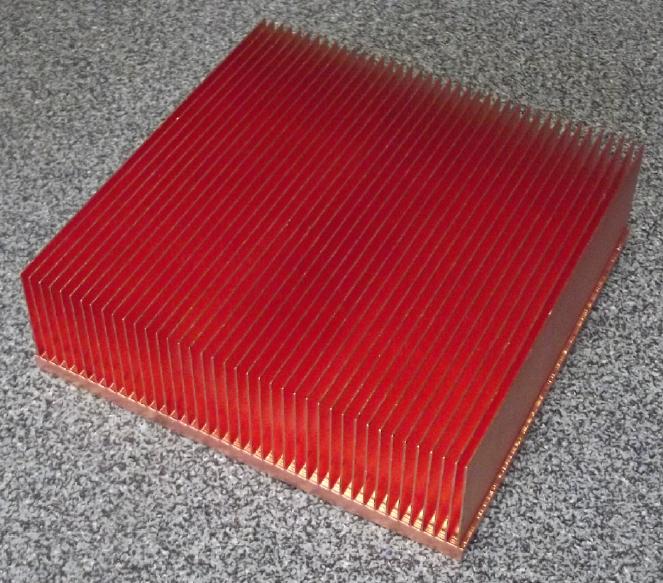 [1st] The (first)
copper heatsink arrived. The
fins were very closely spaced, but they were so thin that air just
passed right through. It seems to me that should be better than
fat
alume
fins, even beyond that it was copper. Surely excellent heat
transfer to
air! I do wonder when they are so thin and with no taper how far
up the
fins the temperature climbs. It's probably not worth having fins
longer
than 30mm (if that) unless the air flow is very slow.
[1st] The (first)
copper heatsink arrived. The
fins were very closely spaced, but they were so thin that air just
passed right through. It seems to me that should be better than
fat
alume
fins, even beyond that it was copper. Surely excellent heat
transfer to
air! I do wonder when they are so thin and with no taper how far
up the
fins the temperature climbs. It's probably not worth having fins
longer
than 30mm (if that) unless the air flow is very slow.
The heat
transfer assembled
in the
open.
 [3rd] I drilled the
bolt
holes and tapped them for
the 1/4" - 20
nylon screws. I would try an intermediate arrangement: the copper
hot
side heatsink with a graphite gasket to the Peltier module,
Peltier via
grahite gasket to the copper block & through the cooler wall,
to
the original alume cold side heatsink. Since I now didn't want to
solder the copper block to the alume heatsink, I just butted them
together like the original [alume block] arrangement. I got the
cooler
together
again, but my confidence that the Peltier module and the two
graphite
heat transfer sheets were properly aligned was low because they
were
inside the
cooler wall where you can't see them as you put it together, and
the
wires of
the Peltier were pushing it around.
[3rd] I drilled the
bolt
holes and tapped them for
the 1/4" - 20
nylon screws. I would try an intermediate arrangement: the copper
hot
side heatsink with a graphite gasket to the Peltier module,
Peltier via
grahite gasket to the copper block & through the cooler wall,
to
the original alume cold side heatsink. Since I now didn't want to
solder the copper block to the alume heatsink, I just butted them
together like the original [alume block] arrangement. I got the
cooler
together
again, but my confidence that the Peltier module and the two
graphite
heat transfer sheets were properly aligned was low because they
were
inside the
cooler wall where you can't see them as you put it together, and
the
wires of
the Peltier were pushing it around.
Anyway the room
temperature
was about 22.3°c and I
started the cooler with 10.0 volts, which was soon doing 3.07A,
30.7W.
(Was the fan that noisy before? I checked TE News #174 to refresh
my
memory. Evidently it was. Looking at it, the fan blades are very
close
to the rough heatsink fins - probably where the "buzz" comes from.
30
watts at 10 volts was also the same power.) In the tests below I
started to regret that I didn't record the times taken for
reaching
different temperatures with different voltages for comparison. But
the
way I was doing it then I don't think I could have. Those tests
only
started from room tempeature once; everything else was
"difference".
Temperature
sensor position (my ref - to be consistent!)
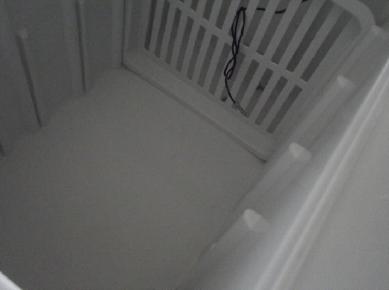 14:20?? 22.3°
14:20?? 22.3°
14:40 18.6°
14:45 17.8°
14:50 17.5 - 30.6W
15:05 16.1 - 30.6
15:31 14.5 - 30.5W
16:37 12.2 - 30.4
16:45 Room 20.5°
17:14 11.8 - 30.4 => 10.5V
17:30 11.6 - 33.4W
17:38 11.6° => 9.5V (27.2W)
19:35 11.0° - 27.4W
19:38 Room 20.0°
Well, that was disappointing
performance. 9° drop instead of 12+.
Well, it's not as well sealed around the heatsinks as before, and
worse, the gaskets may not be well aligned. And just perhaps, more
conductive metal notwithstanding, the thin, narrowly spaced
"skieved"
fins are not as effective as thicker, wider spaced ones.
I wondered what would
happen if there was no gasket (or heatsink paste) between the
module
and the copper? In theory they were both "perfectly" flat and
"should"
touch everywhere. I always feel like heatsink paste is actually
holding
the pieces apart. But they are both hard and unyielding, so in
another
theory
they "should" only touch at 3 points. If there were gaps,
tightening the screws wouldn't do much. I decided to try it out. I
took
it apart again and put it together without the gaskets. I also put
in a
piece of foam rubber on top of the hot side copper heatsink hoping
to
better direct the cooling air through the thin, narrowly spaced
fins.
[June 6th] -- @ 9.5V: (room 19.3°)
9:53 AM, 19.3°, 27.4W -- In the previous test 27.4 Watts with 9.5V
was maintained. Here....
9:58, 18.8, 26.6 -- The dropping in power probably
indicates poorer heat transfer from the Peltier to one or both
heatsinks.
So much for that theory! Good argument for graphite gaskets or
heatsink
paste.
10:03, 18.0 26.6 -- At this point we're not expecting much - and
sure
enough!
10:51 15.9 26.7
11:05 14.2 26.7
11:50 Room 19.1°
12:34 12.4° 26.6W - Less than 7° drop!
(Try again with heatsink compound, or just wait for the second
copper
heatsink?)
[June 12th] I thought to try again simply without the foam that I
hoped was directing air more through the thin, narrowly spaced
copper
heatsink fins.
9:05 AM: room 19.8°. 9.50V.
9:10 26.3W -- again the drop in power suggests poor heat transfer
somewhere. In fact, being even lower already suggests the
heatsinking
was better with the foam. Starting with the Peltier at room
temperature, it's about 31W. Within a second there's heat in the
module's thermocouples and within a few a temperature difference
across
the ceramic, the junctions and into the heatsinks, dropping power
already about 10% and meaning the thermocouples inside have to
work
against a higher temperature differential. If only there was some
way
to thermally connect the thermocouples directly to the metal
heatsinks
without electricly connecting all the separate thermocouples!
9:35 17.2°, 26.3W - Hmm, but it's cooling faster than last time!
Maybe the extra .3W was actually the fan working harder to push
the air?
9:55 16.1
10:05 15.6° -- Okay, that's 4.2° drop from room temperature in
an hour without the foam instead of just 3.5°. Foam rubber wasn't
helpful! It's still not great, so I ended the test.
I took the cooler assembly apart thinking to put in
heatsink grease. I noticed a tiny bit of something stuck to the
hot
side heatsink. That would have held the Peltier from perfect, flat
contact across the face! I wiped off the surfaces again and put it
back
together as it was, no heatsink paste, no graphite. Wow, what a
difference it made!
10:14 AM. Room: 20.0°. Cooler already 19.4° or less. Start ~32W
- dropped fast.
10:19 17.9°, 26.8W -- A bit early to tell since the cooler's
plastic inside face was starting somewhat below room, but power's
up.
10:24 17.3°, 26.7W -- I turned the voltage up to 10.0 momentarily.
Power went up to 29.6W, which is more than even with the graphite.
10:33 16.5°, 26.6W
10:36 16.2°
10:46 15.6°, 26.6W
11:22 14.0°, 26.6
11:29 13.8°, 26.6W
It was better than the previous, but didn't seem it
would
drop by over 10°, so I took it apart and put in some silicone
heatsink compound (including between the Cu block and the Al
inside
heatsink).
11:45 room 20.0°, cooler 18.9°; 9.50V, start 32W -- This time
the watts dropped quite slowly.
11:50 16.8°, 28.3W -- Say, that's more like it!
11:55 15.6°, 28.1W
12:01 14.6°
12:05 14.1
12:18 12.8°
12:22 12.4
12:25 12.1°, 28.1W
12:30 11.8
12:38 11.2
12:49 10.6
13:06 9.9° -- Passed 10° drop, anyway. (& I think the room
is warmer now.)
14:06 8.2°, 28.1W -- Another hour, a little cooler.
14:10 room 21.0 -- 12.8° drop @ 9.5V, 28.1W.
So... 12.8° below room temperature. The best it was with the
original configuration was 12.5°. Pretty small gain. But 12.5°
was at 10 volts. This test was at 9.50 volts. I turned it up to
10.01V,
put the sensor back inside, and left it a while longer. (I wonder
if
the fans need oiling? They might run faster - or quieter! - at the
same
voltage? I oiled the shaft at both ends. No notable change in
sound.)
After I closed it again the temperature rose a bit instead of
falling.
It turned out the room was also getting warmer. It seemed to be a
little over 21°, but I got busy and didn't record the exact
reading.
I left it running at 9.0V. At ~16:00, the room was
21.4° and the cooler was 7.8°. That's a 13.6° spread! Maybe
the copper parts are helping after all. Oh... the sensor was in a
different place, seemingly closer to the fan air's exit. Seems to
make
a notable
difference, so it might not be a fair test.
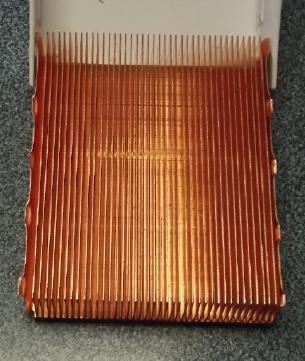 [26th] Near the end of the month the cooling
side
copper heatsink
arrived. I cut it to the same width and bent some "tabs"
onto the
outer
fins so it would hold the plastic cover on the same way the old
one
did. I marked off the bolt holes. It's about 1cm shorter than the
original.
[26th] Near the end of the month the cooling
side
copper heatsink
arrived. I cut it to the same width and bent some "tabs"
onto the
outer
fins so it would hold the plastic cover on the same way the old
one
did. I marked off the bolt holes. It's about 1cm shorter than the
original.
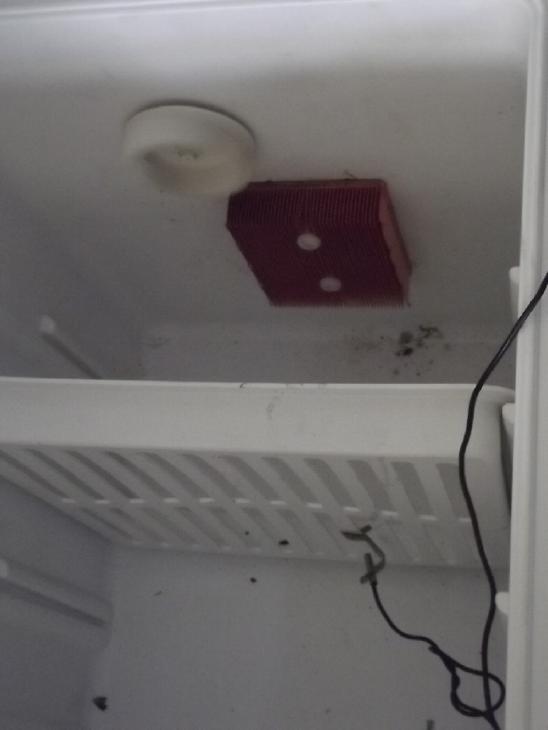 [July 1st] I finally drilled the holes and put it
together. (Hmm, I've taken better fotos!) I also put in a little
spring
clip to hold the temperature sensor in the same place every time.
It
seems quieter now - not that buzz it had before. I had (in
drilling the
holes) placed the new cold side heatsink a little farther from the
fan
since it was shorter anyway. and its fins are different. and it
doesn't
hold the top of the plastic [air duct] cover tight against the
inside
wall.
[July 1st] I finally drilled the holes and put it
together. (Hmm, I've taken better fotos!) I also put in a little
spring
clip to hold the temperature sensor in the same place every time.
It
seems quieter now - not that buzz it had before. I had (in
drilling the
holes) placed the new cold side heatsink a little farther from the
fan
since it was shorter anyway. and its fins are different. and it
doesn't
hold the top of the plastic [air duct] cover tight against the
inside
wall.
11:43 - 9.50V, 20.1°, room 19.7°, 31.1W
11:46 - 19.4° 28.3W
11:48 - 18.7° 28.1W
11:51 to 11:53 - Opened it, tightened clamping screws. After:
28.3W
11:55 - 17.5° 28.3W
12:08 - 14.0, 28.3
12:10 13.3
12:20 12.2°
12:25 11.6, 28.3
12:35 10.6, 28.3
13:05 8.5°, 28.2W
13:15 8.1
13:25 7.5 28.2
14:53 5.2°, 28.2W YES! Refrigerator temperature!
---
14:54 10.00V (changed it), 5.2°, 31.4W
15:06 5.0°, 31.3W
15:12 4.9° Room: 20.5°
15:21 4.8°, 31.3W
15:35 4.7, 31.3, room 20.5
15:43 4.6°, 31.3W, room 20.5°
---
15:45 10.49V (changed again), 4.6°, 34.4W
15:50 4.5° -- 16.0° Drop!
The cooler's temperature didn't seem to drop any
farther
in
another 10 minutes, staying at 4.5 - 4.6°, so I stopped measuring.
(I should have tried a still higher voltage. It may be that with
the
better heat transfer, the
'maximum cooling' voltage may have gone up a little more, eg to
11V.)
[Note: Since I didn't have a fixed temperature sensor position in
the
cooler in my earlier tests, exact comparisons to smaller fractions
of a
degree with those may be inaccurate. The general improvements
however
are observable.]
Conclusions & Remarks
With the original alume heat transfer
components, the greatest temperature drop I measured inside this
same
Coleman cooler was 12.5° [TE
News #174]. In line with my general expectations, the 16.0°
drop measured using copper components is 3.5° colder. Since a
peltier cooler is struggling to get down toward practical
refrigeration
temperatures where food will stay fresh, any improvement is
significant. One would
however have to make copper parts much more cheaply than the
one-off
retail prices I paid for the heatsinks for a commercial unit to be
practical. Although I wasn't successful in my amateur attempts to
cast
copper heatsinks, I'm sure they could be cast or extruded for a
much
lower cost. (The 100$ heatsinks were probably less than 5$ of
actual
copper.) The improved cooler would still cost a premium over the
"cheap" alume versions. It should also have the Peltier Unit
Isolation
noted below.
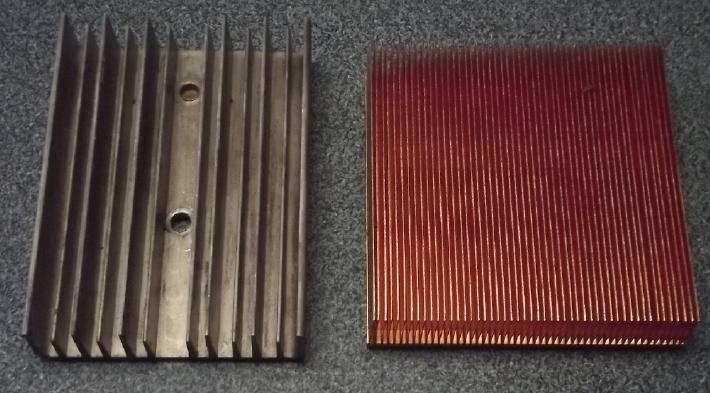 Interestingly, the copper cold side
heatsink
seemed to make more difference than the copper warm side heatsink.
This
may be because the original cold side heatsink to me seemed
a
little underpowered for its job - too few or too small fins, with
a
rather thin (for alume) body.
Interestingly, the copper cold side
heatsink
seemed to make more difference than the copper warm side heatsink.
This
may be because the original cold side heatsink to me seemed
a
little underpowered for its job - too few or too small fins, with
a
rather thin (for alume) body.
But I may have just put the whole thing together a
little
better on this last attempt, too.
I note that Wikipedia says Peltier camping coolers
can
cool up to 20° below ambient (Eg: "45° to 25°"). Not in my
experience! Maybe with a quite small cooler, or one with 4-5
inches of
insulation? My shallow chest fridge did freeze water in the ice
tray... if no fan was running to circulate the cold to the
rest of
the fridge, and if the room wasn't very warm.
Cooling Unit Thermal Isolation
This related piece of design seems to be largely
overlooked. One can insulate as thickly as one wishes, but when
the
power is off, the peltier unit still transfers heat rather rapidly
between the cold and hot side heatsinks, so even a very well
insulated
cooler doesn't stay cold anything like as long as it should. IMHO
the
solution would be for one side to be enclosed in the insulated
wall
with louvered air passages. (Making that the cold side might tend
to
disperse condensation while the unit is turned off?) The
(insulated -
foam?) louvers would blow open when the fan comes on, but remain
shut
when the power is off. The entire peltier cooling unit, both
heatsinks,
would thus drift to the outer or inner temperature (depending
which
side was inside the cooler wall and louvered), without excessive
heat
transfer into the cooler from outside.
I may yet drag out my "superinsulated" shallow chest
Peltier refrigerator from storage and try some of these new
configurations and more copper, and see how cold it can keep food,
and
for how long with the power off. (I know that when I first made it
and
before I cut out a hole and put the peltier cooling system in, it
kept
some containers of ice frozen a very long time. (a couple of days
IIRC?) Afterward it thawed them out much more quickly.)
Better Peltier Modules with Beryllium Oxide Ceramic?
I keep waiting for improved Peltier modules to make a
better solid state fridge with no compressor noise. It occurred
to me that "obviously" there must be considerable heat resistance
through the ceramic faces. The ceramic is "only" about 1mm thick,
and I
thought that even a "thermally conductive" ceramic must be very
high
thermal resistance compared to copper or alume, and that surely
they
must lose at least 2 or 3 degrees from the actual temperature of
the
thermocouples. And it's an extra layer between the
thermocouples
and the heatsink.
Peltier modules could conceivably be put together
without the ceramic faces, although they do provide mechanical
stability and strength. However without the electrical insulation
of
the ceramic the module couldn't be pressed directly against metal
heatsinks. Insulating Kapton tape is only ~.03mm thick instead of
the
1mm of the ceramic. Wouldn't such a thin layer conduct heat
better? On
checking it out I discovered that even the .03mm Kapton tape would
have
almost as high a thermal resistance as the alumina [AKA aluminum
oxide]
ceramic. Little or maybe no gain for a lot of trouble!
BUT!
On looking up the thermal conductivities, I
accidently saw
an interesting figure in the table: sintered beryllium
oxide
ceramic actually has a higher thermal conductivity than
alume
metal! The usual alume oxide ceramic is only 15% as good! BeO is
more
thermally conductive than any other non-metal except diamond.
So the very performance improvement I had envisioned
from eliminating
the ceramic faces could be found instead simply by making Peltier
modules
with (AKA) beryllia ceramic. That's without any hoped-for
thermocouple
technology breakthroughs. I'm sure any manufacturer making them
would
highlight that they used superior material, but I haven't found
any!
Why are they all using
alumina?
Beryllia ceramic used to be used in certain vacuum
tubes,
and it is used in some power semiconductors,
so it's not new. Perhaps it's considered too expensive, or perhaps
there are manufacturing technical problems I don't know about, but
I
expect using it would provide another whole similar level of
improvement to using copper heatsinks instead of alume. (...as
demonstrated in the above experiments.) Maybe that "20°c colder"
camping cooler mentioned on Wikipedia is attainable after all!
(Hmm... Be metal: ~~1000 $/Kg. That is pricey. But for a superior
Peltier
module? It doesn't take much, and there's nearly twice as much
mass of
oxygen as beryllium in BeO oxide. atomic weights Be:9, O:16! BeO
powder/dust is carcinogenic, so a manufacturing facility
would
need to prevent exposure.)
I emailed someone who makes thermoelectric
generators,
Peltier modules and equipment using them, and he didn't know why
Al2O3
is used instead of BeO. Evidently they just order what is
available and
economic from suppliers. I could ask about feasibility at
ceramic/pottery places, but I couldn't put together Peltier
modules
even if I had the ceramics. (A proper factory putting together
modules
with superior performance might do really well even if they cost
more?)
June
Gardening
 [13th] Some powerful gusts of wind
pulled the cover off
the
greenhouse with the corn. I had planned to take it off at the end
of
the
month so the corn would get more light. It's still rather chilly
at
night, but I'll leave it off. (And the next days were cold and
rainy.
And deer came through chomping off the tops of tender young corn
sprouts. Ug! I think the corn will be a wipeout, but some squash
and
potatos sprouted here and there in the same beds. Maybe I'll get
something!)
[13th] Some powerful gusts of wind
pulled the cover off
the
greenhouse with the corn. I had planned to take it off at the end
of
the
month so the corn would get more light. It's still rather chilly
at
night, but I'll leave it off. (And the next days were cold and
rainy.
And deer came through chomping off the tops of tender young corn
sprouts. Ug! I think the corn will be a wipeout, but some squash
and
potatos sprouted here and there in the same beds. Maybe I'll get
something!)
[14th] With the cover off the poles & plastic greenhouse, it
was
apparent at 11:30 PST that there was a tree shadow across the corn
patch and that it would have been better closer to the house. That
got
me thinking about my original plan for a garden: move the fence by
the
house over and have more garden on the outside side of the
sidewalk.
That was the sunniest and most convenient place.
What had stopped that plan? One thing was the lack of
any
way short of more labor than I was capable of to rip up the lawn
and
make it into a garden bed. But now I had the rototiller to assist!
The
other was the solar panels on the lawn there. Somehow this visual
impediment had put it "out of sight out of mind". Suddenly it
seemed
like a great plan again. Now it seemed I had made that whole
"main"
garden down the hill when everything would be better up by the
house,
and more convenient. Oh well, I have more garden space than I
would
have had. In fact, with my 'tennis elbow' I don't expect to even
plant
the last corner.
But I may well do it next spring. Maybe I should move
the
fence over and put cardboard down now, since that seems very
helpful
for reducing the grass. At least put the cardboard down!
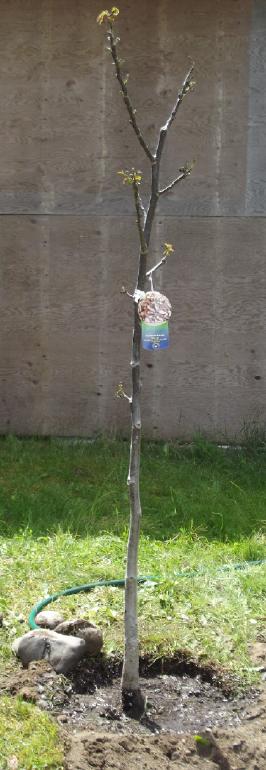
 [16th] When I bought my
english walnut tree
(carpathian)
this spring I was excited and mentioned it to Dan and Jeanette,
who I
saw in town. They went right
to the store and bought one of each cool weather variety,
carpathian
and manregion.
[16th] When I bought my
english walnut tree
(carpathian)
this spring I was excited and mentioned it to Dan and Jeanette,
who I
saw in town. They went right
to the store and bought one of each cool weather variety,
carpathian
and manregion.
At home they had looked them up and realized they get
big,
and weren't sure where they could put them. I went to their place
to
drop something off. I looked at them and while the carpathian
looked
good, the manregion's leaves were shrivelling up instead of
growing.
There were still some new green buds. I left a phone message
saying
they couldn't let it die -- I wanted it and would buy it from
them.
(Their hose was nearby so I watered them and noticed the water
seemed
to run right through the pot and out the bottom. It didn't seem to
hold
much of it. That was probably the trouble. It needed to be out of
there
and planted, or at least repotted, ASAP or sooner.)
I didn't buy one of each in the spring. But later I
had figured a place to put a second one, and having seen this one
not
doing
well in its pot, I had already had my eye on it. Thinking they
were
likely to give it to me now since it was obviously dying, I cut
down a
pine tree by the driveway near where I wanted to
plant it so it could get more light. If not... next spring the
store
could get more? (It was a lot of work - I had to get the pine out
of
the driveway - and now a zillion branches to deal with, ug!) When
I
finally got back in the house a phone message said they were
driving
from Port Clements to my place with the tree. I got it cheap. I
planted
it the next morning and gave it lots of water. Hopefully it will
recover.
[18th] On looking at the new tree I wasn't sure it didn't look
worse
than when Dan brought it. I decided on mainline transfusion: I put
the
hose by it and left it running on low the rest of the day until
bedtime, then turned it on again the next morning. And the next
day. It
still looked worse and worse. I switched to watering twice a day.
"Fingers crossed" as they say.
[July] It didn't recover. Apparently the main
trunk had already died and carried no sap, so the buds wilted. Now I'm
hoping it will come back from the
roots. But the one from last year that I didn't water
enough didn't. (Now
my brother says he'll bring a black walnut sapling from
Ontario this fall! Even better!)
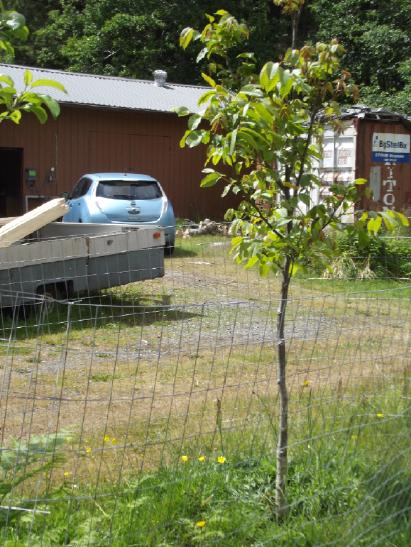 The new
"Carpathian"
tree (watered daily until early July, now every 2nd day) is
growing really well.
The new
"Carpathian"
tree (watered daily until early July, now every 2nd day) is
growing really well.
[22nd] Egads - I left the main garden gate open last night. I was
going
to plant the hazelnut tree, then somehow I got sidetracked. For a
while
I thought all was okay, then I noticed half of my 2 rows of
romaine
lettuce, expected to be ready for the little Sunday "Tlell
Farmers'
Market" in a couple of weeks, were eaten nearly to the ground!
[23rd] I took away the wire circles around my fruit trees (one at
a
time) and mowed the 3 foot tall grass and ferns around them. Later
while I was watering the same trees I noticed a branch move rather
violently out the corner of my eye. The wire around that tree
(48")
wasn't tall enough and with
the grass and ferns gone, a deer was munching down the ends of the
branches. I shooed it away and put some chicken wire above. Soon
it was
back looking for a way in. Then it moved over to the next tree
considering if it could reach a branch of that one. I shooed it
again
and widened its wire circle.
After I had everything nice and looking like a kept
lawn,
some squirrel or something went up both pear trees and nipped off
the
stems of each and every tiny growing pear, and left them on the
ground.
(There weren't very many. But it's the first time they were
going to produce any pears, with me having got a flowering
branch from another variety this spring and got cross polination.)
I
think the creature did in some apples, too, because I thought
there
were more.
Note to self: DO NOT mow under fruit trees from flowering time
until
the fruit is harvested, no matter how tall and gnarly the grass,
weeds
and ferns. Those are what keep the squirrels(?) away - not to
mention
the deer! Just another of various gardening secrets one doesn't
learn
in a week or even in a year or two when gardening in a new place.
 [22nd-24th] I pulled
up the
ground cover from the last unprepared corner of the garden, which
I
hadn't got into for a couple of years: old swimming pool vinyl and
much
decaying
cardboard
with all its little plastic tape and barcode label bits. (Bits of
PLASTIC - Plastic is Everywhere! - GRR!)
[22nd-24th] I pulled
up the
ground cover from the last unprepared corner of the garden, which
I
hadn't got into for a couple of years: old swimming pool vinyl and
much
decaying
cardboard
with all its little plastic tape and barcode label bits. (Bits of
PLASTIC - Plastic is Everywhere! - GRR!)
Then rototill, rake
up roots and sieve the dirt. I planted some edible
pod
peas, bush beans and a short row of romaine lettuce, with room for
a
few more rows of somethings. In the next couple of days I had
cleared
and planted more beans right to the fence: All spring planting,
Finished at last (26th)!
Other
corners of the main
garden: NW, SE, S. half (NE is raspberries... & grass)
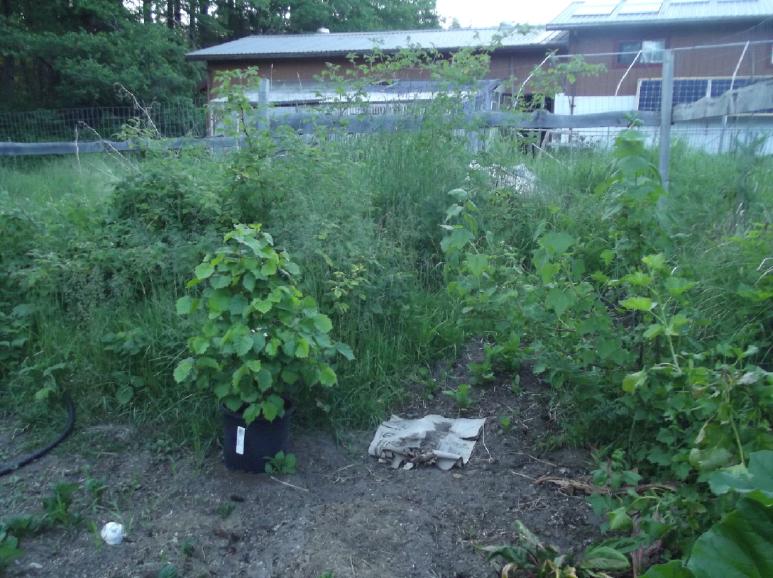
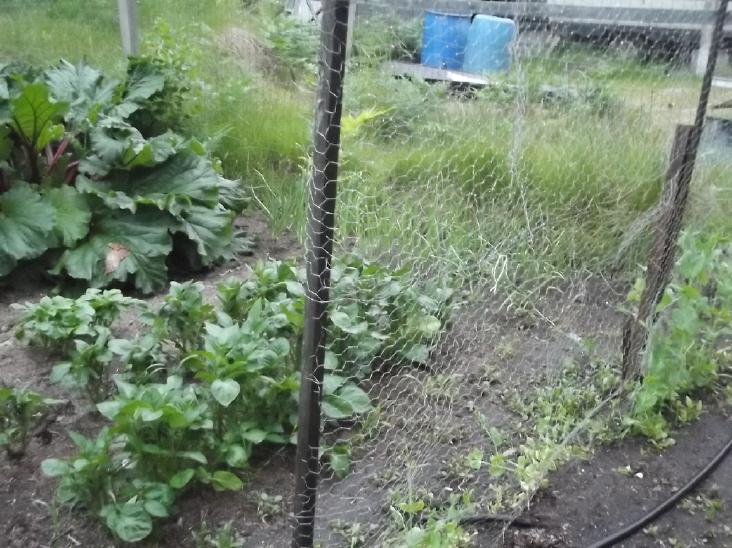
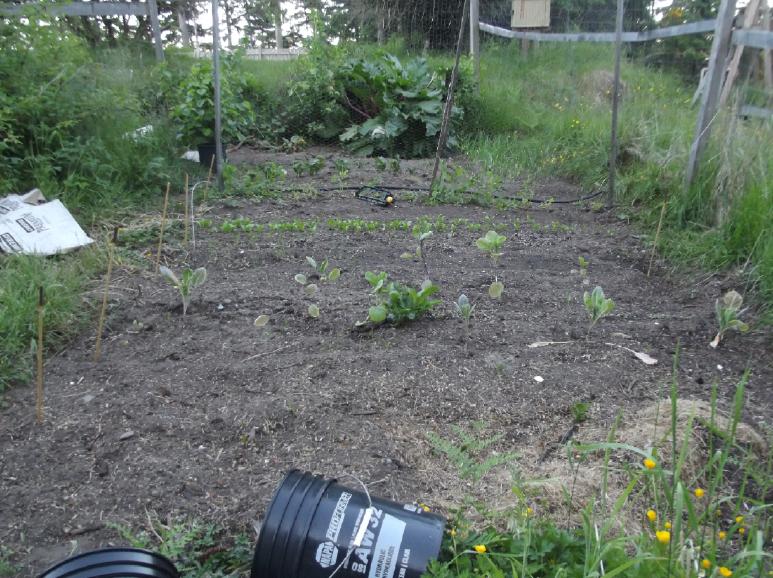
I kept planting more corn
until July, but it didn't seem to grow. I finally realized that in
spite of putting some boards over it to discourage them, the deer
were
ducking under and eating the tender corn seedlings, and the tips
of
taller ones. I'll have no corn this year! They also polished off a
couple of volunteer cabbages in the same patch. But they seem to
have
left the squashes with their prickly leaves, so maybe I'll get a
few of
those. This is good to know for next year: squashes can be grown
in the
open! (Hmm... the slugs haven't been bad this year. Squashes need
slug
protection when small.)
And way off in my far potato patch, apparently no one
told
the deer potato leaves are poisonous and they have done much
damage -
apparently mostly to varieties with lighter green leaves. (Is that
why
I seem to have no purple or pink flesh potatos any more?) I had
thought
that potatos was at least one crop that didn't need to be fenced
in!
 And
there was
some volunteer quinoa and sunflowers at the septic tank field -
leftover chicken feed - until the deer ate those and just left the
thistles, and some grain which they'll no doubt munch up when the
seed
is ripening.
And
there was
some volunteer quinoa and sunflowers at the septic tank field -
leftover chicken feed - until the deer ate those and just left the
thistles, and some grain which they'll no doubt munch up when the
seed
is ripening.
Some venison for the freezer this fall is starting to
seem
more and more a just and fair proposition. On this archipelago
they are
an introduced species with no predators besides hunters, and they
are
spoiling the forest by overgrazing the understory plants.
I plan for next year to
double my 'south wall of house' garden (where plants that like it
warmer grow best and it's easiest to keep the deer out). I had
been
thinking of this for years, but again the small rototiller should
now
make it practical to turn lawn into garden. If I had done it
before, I
might never have made the big "main" garden. But I'm presently
spreading thick grass clippings, cardboard and some plastic ground
cover over the area to smother the grass and make it much easier
next
spring. I should have done it years ago.
I'm also frequently bringing a bucket of seaweed from
the
beach for fertilizer and mulch on the gardens. Why add mostly
packaged
fertilizer to loose, sandy soil when you live next to an ocean
beach?
(Not that I don't supplement a bit when planting - lime/calcium,
woodstove
ashes, borax, and a little "NPK" fertilizer, bone meal when
planting
trees and bushes...)
Electricity
Storage
(No Reports)
Electricity
Generation
My Solar Power System
The Usual Daily/Monthly/Yearly Log of Solar
Power Generated [and grid power consumed]
(All times are in PST: clock 48 minutes ahead of local sun time,
not
PDT which
is an hour and 48 minutes ahead. (DC) battery system power output
readings are reset to zero
daily (often just for LED lights, occasionally used with other
loads:
Chevy Sprint electric car, inverters in power outages or other 36V
loads), while the
grid tied readings are cumulative.)
Daily Figures
Notes: House Main
meter (6 digits) accumulates. DC meter now
accumulates until [before] it loses precision (9.999 WH => 0010
KWH), then is
reset. House East and Cabin meters (4
digits) are reset to 0 when they get near 99.99 (which goes to
"100.0")
- owing to loss of second decimal precision.
Km = Nissan Leaf electric car drove distance, then car was
charged.
New Order of Daily Solar Readings (Beginning May 2022):
Date House, House, House, Cabin => Total KWH Solar [Notable
power
Uses; Grid power meter@time] Sky/weather
Main
DC East Cabin
May
31st 4885.08, 7.22, 37.55, 34.89 => 19.53 [7902@21:00]
June
1st 4889.18, 7.24, 40.54, 37.51 => 9.73 [55Km;
7924@21:30] 12° - ug!
2nd4895.64, 7.30, 45.67, 42.09 => 16.23 [85Km; 7952@21:30]
16.6°
max but mostly closer to 12.
3rd 4904.99, 7.70, 53.24, 48.49 => 23.72 [55Km; 7970@21:00]
lost
3/4?KWH with cabin cord unplugged ~1Hr for mowing lawn. DC use:
charged
some batteries.
4th 4912.88, 7.92, 59.43, 54.33 => 20.14 [35Km; 7992@21:00] DC
use:
Ran Chevy Sprint around the yard.
5th 4920.43, 8.26, 65.98, 59.93 => 21.04 [7999@21:00] ~300 WH
to run
the Sprint 1 Km? Well, it is rough ground, and not a very
efficient
motor.
6th 4930.11, 8,47, 73.98, 66.74 => 24.70 [55Km; 8016@21:00;
50Km]
Best in 2 weeks notwithstanding the spreading jet trails.
7th 4940.01, 8,57, 81.91, 68.97 => 20.16 [80.32@21:30]
Something
seems wrong down at the cabin... was expecting 6KWH there, 24
total!
8th 4947.85, 8.63, 87.77, 70.37 => 15.16 [90Km; 8044@21:00]
Didn't
have time to look at it - just 1.4 KWH, from small grid tie on 1
collector.
9th 4955.54, 8.69, 93.71, 71.74 => 15.06 [175Km; 8074@22:00]
Main
grid tie for cabin definitely not working - no blown fuses,
nothing,
just doesn't put out. Red light stays on as if no AC connection.
(Yes I
tried
another cord.) I drove the Leaf to Masset... at 65KmPH. Charged at
new
charging station there, so only last
90Km was recharged from my own charging station.
10th 4963.89, 8.80, 7.06, 73.59 => 17.37 [105Km;
8095@21:30]
11th 4973.29, 8.89, 14.27, 77.43 => 20.54 [35Km; 8110@21:00]
Cabin:
Moved 2 more collectors to the "700W" grid tie.
12th 4980.02, 9.63, 20.03, 81.34 => 17.14 [8118@21:00] Why the
DC
was so big: Ran the Sprint car around the acreage a couple of
times and
then plugged it in; Ran some Peltier cooler tests. Ordered 2
more 1000W grid ties. I don't like the "1400W" ones (like the one
that
just failed) because they don't seem to put out much (any?) more
power
than the "1000W" -- they just get really hot before the cooling
fan
comes on.
13th 4991.77+0.48, 9.72, 29.12, 86.17=> 25.76 [55Km;
8134@21:30]
Gee, sunny! - should have been YTD record if cabin grid tie had
been
working. Something funny happened in a brief power failure in the
morning and I accidently reset KWH on the house meter to zero. (I
remembered seeing the last two digits (.77) just before I did it,
and
the
coarser unit KWH '91' (not '90' or '92') was derived from the
relation
to the
carport reading, so
I'm pretty sure I got the exact figure.)
14th 8.83, 9.78, 36.01, 90.25 => 16.38 [70Km;
8152@21:30]
15th 12.23, .06, 38.36, 92.14 => 7.70
[8166@21:30] Cold & rainy.
16th 17.17, .12, 41.98, 94.86 => 11.34 [90Km;
8190@21:30] 8° at night.
17th 24.88, .26, 46.08, 98.66 => 16.75 [110Km;
8215@21:30] -- Unplugged 1000W grid tie to plug in chainsaw &
forgot to plug it back in. Oops.
18th 31.48, .32, 49.69, 3.59 => 13.86
[8228@21:30] Still pretty cool. "Tuque weather"
19th 42.04, .39, 55.84, 7.76 => 20.95
[8239@22:00] Wow! Sunny & warm today - almost hot! (didn't
check
thermometer.)
20th 52.24, .45, 61.43, 12.29 => 20.37 [70Km;
8257@21:30] Beautiful again!
21st 61.18, .53, 66.12, 16.64 => 18.06
[20Km;8270@21:30]
Summer solstice! (& it was nice out!)
22d 72.25, .60, 71.98, 21.19 => 21.44
[8279@21:30]
Sunny, even hot. Evening: Exchanged 1000W grid tie in carport with
700W
in cabin - Surely will get more from the 4 collectors on the cabin
with
1000W one, and not much less from the 2 on the pole with the 700W.
But
I discovered the 1000W one had been doing nothing since 17th, when
I
unplugged it to plug in the electric chainsaw to cut down pine
tree,
and forgot about it. Oops! No wonder KWH seemed to be down even
more in
spite of the sunniest days, right at the summer solstice. All told
must
have been missing 4-5 KWH/Day. (Now, if there's another sunny day,
we
should see the difference.)
23rd 77.68, .66, 76.03, 24.88 => 13.23
[90Km;
8298@22:00] Cloudy. No rain.
24th 87.17, .73, 83.26, 31.69 => 23.60 [60Km;
8312@21:30]
Sunny PM. Warm. (21°?) Definitely improved KWH!
25th 95.70, .81, 89.67, 37.81 => 21.14
[3Km;
8317@21:00]
Sunny AM, Cloudy PM.
26th 103.25, .89, 95.31, 42.85 => 18.32
[8327@21:00]
Light clouds.
FINISHED planting garden!
27th 112.81, .98, 8.19, 50.31 => 25.33
[8333@24:00]
Almost totally sunny - a few jet trails later PM. (Expect
>
10 KWH from house! A grid tie keeps resetting to zero, working
gradually up to 500W, and then dropping again - in a clear blue
sky.
???) Oh, wait... I had the house power shut off overnight until ?
9AM.
Might have lost a KWH or so in the morning, including some from
house.
28th 118.67, 1.04, 12.47, 54.20 => 14.09 [55Km; 8342@21:30]
Rained
overnite. Light cloud.
29th 123.95, 1.10, 16.11, 57.96 => 12.74 [8350@21:00] A few
sprinkles of "mist" rain.
30th 130.86, 1.14, 21.09, 62.54 => 16.51 [55Km; 8366@21:00] Too
cool
- had to turn on bedroom heat early AM. It shows!
July
1st 137.45, 1.48, 26.65, 67.37 => 17.32 [8478@22:00] Bedroom
heat
burns electricity - and at the wrong time of day! Cloudy again.
2d 146.83, 1.59, 34.26, 74.18 => 23.91 [85Km; 8395@21:30]
Sunny & clear
3rd 157.39, 1.61, 40.97, 81.64 => 24.75 [8404@21:00] Clouded
over
toward eve.
4th 167.72, 1.65, 45.30, 89.38 => 22.44 [50Km; 8416@21:00]
Something
is wrong with a "700W" grid tie in the carport. Collection from
carport
is half, and its light stays green even if it's unplugged from the
AC.
The other two turn red if unplugged. Are the wired-in ones for 3x
the
price more reliable? (Do you know if they've quit?) I have the two
1000W plugin ones coming, but I'm losing quite a lot of KWH
through the
peak summer period!
5th 178.59, 1.68, 51.27, 96.26 => 23.75 [8423@21:00] 25° out!
Swapped two grid ties in carport - now the good one is on 2 panels
instead of 1. Cabin was off line for an hour midday. (3/4 KWH
lost?)
6th 189.05, 1.75, 59.31, 7.76 => 26.33 [55Km;
8433@21:00] (best since May.) 26°!
7th 199.73, 1.80, 67.19, 12.29 => 23.14 [90Km; 8445@21:00]
Cabin was
off half the day ~ -3.5KWH? Not as warm out, still sunny &
warm.
Very foggy eve.
8th 206.26, 1.87, 72.07, 14.93 => 13.84 [55Km; 8462@21:00;
50Km]
Cloudy, cooler.
9th 211.03, [off], 75.74, 18.22 => 11.73 [35Km; 8474@21:00] A
few
drops ov rain. [using Sprint around acreage - unplugged DC]
10t 221.09, 2.11, 83.95, 25.57 => 25.93 [8480@22:00]
11t 229.79, 2.16, 91.03, 31.66 => 21.92 [65Km; 8493@21:00]
Chart of daily KWH from solar panels.
(Compare JUNE 2023
(left) with May 2023 & with June 2022.)
Days of
__ KWH
|
June 2023
(18..15..17..15
..18 collectors)
|
May 2023
(18 solars)
|
June 2022
(18 s. panels)
|
0.xx
|
|
|
|
1.xx
|
|
|
|
2.xx
|
|
|
|
3.xx
|
|
|
|
4.xx
|
|
|
1
|
5.xx
|
|
2
|
|
6.xx
|
|
|
|
7.xx
|
1
|
|
1
|
8.xx
|
|
|
1
|
9.xx
|
1
|
1
|
2
|
10.xx
|
|
1
|
1
|
11.xx
|
1
|
|
1
|
12.xx
|
1
|
1
|
1
|
13.xx
|
2
|
|
2
|
14.xx
|
1
|
1
|
2
|
15.xx
|
2
|
|
2
|
16.xx
|
4
|
2
|
3
|
17.xx
|
2
|
1
|
|
18.xx
|
2
|
2
|
|
19.xx
|
|
|
1
|
20.xx
|
5
|
2
|
1
|
21.xx
|
3
|
1
|
2
|
22.xx
|
|
1
|
1
|
23.xx
|
2
|
2
|
|
24.xx
|
1
|
3
|
2
|
25.xx
|
2
|
1
|
1
|
26.xx
|
|
3
|
|
27.xx
|
|
3
|
|
28.xx
|
|
2
|
2
|
29.xx
|
|
1
|
2
|
30.xx
|
|
|
|
31.xx
|
|
|
1 (All time
1-day record
31.00 KWH) |
Total KWH
for month
|
540.12
|
642.52 (All time
monthly record)
|
536.52 |
Km Driven
on Electricity
|
1407.7 Km
(190 KWH?)
|
1207.4 Km
(175 KWH?) |
934.1 Km
(~140 KWH?) |
Things Noted - June 2023
* Sunshine: May was very sunny - much sunnier than
June -- and than May 2022. But little rain in June. Just clouds.
Monthly Summaries: Solar Generated KWH [& Power used
from
grid KWH]
As these tables are getting long, I'm not repeating the log of
monthly
reports. The reports for the first four full years (March 2019 to
February 2023) may be found in TE
News #177, February 2023.
2023 - (House roof, lawn + DC + Cabin + Carport, Pole)
Solar
Jan KWH: 40.57 + 3.06 + 28.31 + 21.85 = 93.79 Solar [grid: 1163;
car
(these are very rough estimates): 130]
Feb KWH: 59.19 + 2.70 + 38.10 + 32.47 = 132.46 Solar [grid: 1079;
car:
110]
Four years of solar!
Mar KWH: 149.49 + 2.72 + 53.85 + 92.08 = 298.14
Solar
[grid: 981; car:
140]
Apr KWH: 176.57 + 2.71 + 121.21 + 108.34 = 408.83 [grid: 676; car:
160]
May KWH:266.04 + 2.04 + 194.13 + 180.31 = 642.52 [grid: 500; car:
175]
Jun KWH: 237.55 + 3.70 + 172.56 + 126.31 = 540.12 [grid: 464; car:
190]
Annual Totals
1. March 2019-Feb. 2020: 2196.15 KWH Solar [used 7927
KWH
from grid]
2. March 2020-Feb. 2021: 2069.82 KWH Solar [used 11294 KWH from
grid]
(More electric heat - BR, Trailer & Perry's RV)
3. March 2021-Feb. 2022: 2063.05 KWH Solar [used 10977 KWH from
grid]
4a. March 2022-August 2022: in (the best) 6 months, about 2725 KWH
solar - more than in any previous entire year!
4. March2022-Feb. 2023: 3793.37 KWH Solar [used 12038 KWH from
grid]
Money Saved or Earned - @ 12¢ [All BC residential elec.
rate] ; @
50¢ [2018 cost of diesel fuel to BC Hydro] ; @ 1$ per KWH [actual
total
cost to BC Hydro
in 2022 according to an employee]:
1. 263.42$ ; 1097.58$ ; 2196.15$
2. 248.38$ ; 1034.91$ ; 2069.82$
3. 247.57$ ; 1031.53$ ; 2063.05$
4. 455.20$ ; 1896.69$ ; 3793.37$
It can be seen that the benefit to the society as a
whole
on Haida Gwaii from solar power installations is much greater than
the
cost savings to the individual user of electricity, thanks to the
heavy
subsidization of our power
owing to the BC government policy of having the same power rate
across
the entire province regardless of the cost of production. And it
can be
insurance: With some
extra equipment and a battery, sufficient solar can deliver
essential
power in
electrical outages however long. (Feb 28th 2023: And it's probably
well
over 1$/KWH by now the way inflation of diesel fuel and other
costs is
running.)
https://www.TurquoiseEnergy.com
Haida Gwaii, BC Canada


 Having cast
a
copper heat transfer block, I bought a pricey copper heatsink
and ran
some tests with the same camping cooler. Then I got another copper
heatsink for the cold side too, and ran some more. Instead of
12.5°
cooling, with all copper heat transfer components it got about 16°
colder than the room. In a 20° room that makes for refrigerator
temperatures, from about 30 watts of power at 10 volts. If it's
30°
out, that still makes for 14° in the cooler instead of 17.5°.
Owing to difference of shapes and numbers of fins in the
heatsinks,
it's hard to tell exactly what features caused the improvement,
but it
was right in line with my expectations ("4° colder") for how much
better copper would be than alume.
Having cast
a
copper heat transfer block, I bought a pricey copper heatsink
and ran
some tests with the same camping cooler. Then I got another copper
heatsink for the cold side too, and ran some more. Instead of
12.5°
cooling, with all copper heat transfer components it got about 16°
colder than the room. In a 20° room that makes for refrigerator
temperatures, from about 30 watts of power at 10 volts. If it's
30°
out, that still makes for 14° in the cooler instead of 17.5°.
Owing to difference of shapes and numbers of fins in the
heatsinks,
it's hard to tell exactly what features caused the improvement,
but it
was right in line with my expectations ("4° colder") for how much
better copper would be than alume. And, looking for a way
to
improve heat transfer in and out of Peltier modules themselves, I
discovered in a table that while being an electrical insulator,
beryllium oxide ceramic actually has better heat conductivity than
alume metal! It's the highest of any non-metal except diamond. A
Peltier module made with that instead of alume oxide (only 15% as
good)
would probably drop the cooler another 4° - right down to
freezing!
And, looking for a way
to
improve heat transfer in and out of Peltier modules themselves, I
discovered in a table that while being an electrical insulator,
beryllium oxide ceramic actually has better heat conductivity than
alume metal! It's the highest of any non-metal except diamond. A
Peltier module made with that instead of alume oxide (only 15% as
good)
would probably drop the cooler another 4° - right down to
freezing!

 The
rototiller
I
got
last
fall,
along with "the claw" (four long, hard
tines rake), a shovel and the dirt siever, made it possible to
turn the ground in the gardens from tall grass with an
"impenetrable"
thatch of
roots into plantable soil with most of the grass and weed roots
removed. I had been wanting to do this for a few years but
breaking
through the roots with a shovel and a bad back was just too hard.
The
rototiller
I
got
last
fall,
along with "the claw" (four long, hard
tines rake), a shovel and the dirt siever, made it possible to
turn the ground in the gardens from tall grass with an
"impenetrable"
thatch of
roots into plantable soil with most of the grass and weed roots
removed. I had been wanting to do this for a few years but
breaking
through the roots with a shovel and a bad back was just too hard. Magnetic Variable Torque Converter I
finished
filing out
the center hole in the rather dubious poured copper disk, and
attached
it to the shaft. That's as far as
I got. (Months are going by! Yikes!)
Magnetic Variable Torque Converter I
finished
filing out
the center hole in the rather dubious poured copper disk, and
attached
it to the shaft. That's as far as
I got. (Months are going by! Yikes!)


 From the
article:
From the
article:
 [1st] The (first)
copper heatsink arrived. The
fins were very closely spaced, but they were so thin that air just
passed right through. It seems to me that should be better than
fat
alume
fins, even beyond that it was copper. Surely excellent heat
transfer to
air! I do wonder when they are so thin and with no taper how far
up the
fins the temperature climbs. It's probably not worth having fins
longer
than 30mm (if that) unless the air flow is very slow.
[1st] The (first)
copper heatsink arrived. The
fins were very closely spaced, but they were so thin that air just
passed right through. It seems to me that should be better than
fat
alume
fins, even beyond that it was copper. Surely excellent heat
transfer to
air! I do wonder when they are so thin and with no taper how far
up the
fins the temperature climbs. It's probably not worth having fins
longer
than 30mm (if that) unless the air flow is very slow. [3rd] I drilled the
bolt
holes and tapped them for
the 1/4" - 20
nylon screws. I would try an intermediate arrangement: the copper
hot
side heatsink with a graphite gasket to the Peltier module,
Peltier via
grahite gasket to the copper block & through the cooler wall,
to
the original alume cold side heatsink. Since I now didn't want to
solder the copper block to the alume heatsink, I just butted them
together like the original [alume block] arrangement. I got the
cooler
together
again, but my confidence that the Peltier module and the two
graphite
heat transfer sheets were properly aligned was low because they
were
inside the
cooler wall where you can't see them as you put it together, and
the
wires of
the Peltier were pushing it around.
[3rd] I drilled the
bolt
holes and tapped them for
the 1/4" - 20
nylon screws. I would try an intermediate arrangement: the copper
hot
side heatsink with a graphite gasket to the Peltier module,
Peltier via
grahite gasket to the copper block & through the cooler wall,
to
the original alume cold side heatsink. Since I now didn't want to
solder the copper block to the alume heatsink, I just butted them
together like the original [alume block] arrangement. I got the
cooler
together
again, but my confidence that the Peltier module and the two
graphite
heat transfer sheets were properly aligned was low because they
were
inside the
cooler wall where you can't see them as you put it together, and
the
wires of
the Peltier were pushing it around. 14:20?? 22.3°
14:20?? 22.3° [26th] Near the end of the month the cooling
side
copper heatsink
arrived. I cut it to the same width and bent some "tabs"
onto the
outer
fins so it would hold the plastic cover on the same way the old
one
did. I marked off the bolt holes. It's about 1cm shorter than the
original.
[26th] Near the end of the month the cooling
side
copper heatsink
arrived. I cut it to the same width and bent some "tabs"
onto the
outer
fins so it would hold the plastic cover on the same way the old
one
did. I marked off the bolt holes. It's about 1cm shorter than the
original. [July 1st] I finally drilled the holes and put it
together. (Hmm, I've taken better fotos!) I also put in a little
spring
clip to hold the temperature sensor in the same place every time.
It
seems quieter now - not that buzz it had before. I had (in
drilling the
holes) placed the new cold side heatsink a little farther from the
fan
since it was shorter anyway. and its fins are different. and it
doesn't
hold the top of the plastic [air duct] cover tight against the
inside
wall.
[July 1st] I finally drilled the holes and put it
together. (Hmm, I've taken better fotos!) I also put in a little
spring
clip to hold the temperature sensor in the same place every time.
It
seems quieter now - not that buzz it had before. I had (in
drilling the
holes) placed the new cold side heatsink a little farther from the
fan
since it was shorter anyway. and its fins are different. and it
doesn't
hold the top of the plastic [air duct] cover tight against the
inside
wall. Interestingly, the copper cold side
heatsink
seemed to make more difference than the copper warm side heatsink.
This
may be because the original cold side heatsink to me seemed
a
little underpowered for its job - too few or too small fins, with
a
rather thin (for alume) body.
Interestingly, the copper cold side
heatsink
seemed to make more difference than the copper warm side heatsink.
This
may be because the original cold side heatsink to me seemed
a
little underpowered for its job - too few or too small fins, with
a
rather thin (for alume) body. [13th] Some powerful gusts of wind
pulled the cover off
the
greenhouse with the corn. I had planned to take it off at the end
of
the
month so the corn would get more light. It's still rather chilly
at
night, but I'll leave it off. (And the next days were cold and
rainy.
And deer came through chomping off the tops of tender young corn
sprouts. Ug! I think the corn will be a wipeout, but some squash
and
potatos sprouted here and there in the same beds. Maybe I'll get
something!)
[13th] Some powerful gusts of wind
pulled the cover off
the
greenhouse with the corn. I had planned to take it off at the end
of
the
month so the corn would get more light. It's still rather chilly
at
night, but I'll leave it off. (And the next days were cold and
rainy.
And deer came through chomping off the tops of tender young corn
sprouts. Ug! I think the corn will be a wipeout, but some squash
and
potatos sprouted here and there in the same beds. Maybe I'll get
something!)
 [16th] When I bought my
english walnut tree
(carpathian)
this spring I was excited and mentioned it to Dan and Jeanette,
who I
saw in town. They went right
to the store and bought one of each cool weather variety,
carpathian
and manregion.
[16th] When I bought my
english walnut tree
(carpathian)
this spring I was excited and mentioned it to Dan and Jeanette,
who I
saw in town. They went right
to the store and bought one of each cool weather variety,
carpathian
and manregion. The new
"Carpathian"
tree (watered daily until early July, now every 2nd day) is
growing really well.
The new
"Carpathian"
tree (watered daily until early July, now every 2nd day) is
growing really well. [22nd-24th] I pulled
up the
ground cover from the last unprepared corner of the garden, which
I
hadn't got into for a couple of years: old swimming pool vinyl and
much
decaying
cardboard
with all its little plastic tape and barcode label bits. (Bits of
PLASTIC - Plastic is Everywhere! - GRR!)
[22nd-24th] I pulled
up the
ground cover from the last unprepared corner of the garden, which
I
hadn't got into for a couple of years: old swimming pool vinyl and
much
decaying
cardboard
with all its little plastic tape and barcode label bits. (Bits of
PLASTIC - Plastic is Everywhere! - GRR!)


 And
there was
some volunteer quinoa and sunflowers at the septic tank field -
leftover chicken feed - until the deer ate those and just left the
thistles, and some grain which they'll no doubt munch up when the
seed
is ripening.
And
there was
some volunteer quinoa and sunflowers at the septic tank field -
leftover chicken feed - until the deer ate those and just left the
thistles, and some grain which they'll no doubt munch up when the
seed
is ripening.